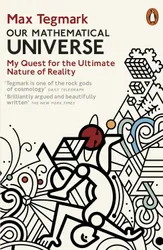This is a book that explores the nature of our reality. Unlike Existential Physics, this book is prepared to venture into wild speculation about things that cannot (currently) be tested experimentally. In that sense, it’s more in line with the view I expressed in that review, that there shouldn’t be limits to the areas that science investigates. Tegmark talks about how he’s had to be careful to limit the number of more speculative papers he writes, in order to continue to have a reputable career in physics. In this book he allows himself to reach beyond conventional physics and into the kind of speculation that may have got him into trouble in more formal papers.
One of these more speculative areas is the concept of multiverses. Tegmark talks about a few different kinds of multiverse that might exist, either with or without the same laws of physics as the one we find ourselves within. I found the discussion of the concept of “inflation” and the big bang really interesting. Particularly intriguing was the idea that the big bang is just what we call the end of inflation in our part of space, but similar phenomena could be occurring in parts of space that are very far away. We would never know because the light from them hasn’t reached us yet (and may never reach us), and in parts of our universe’s history the universe was opaque to light, so we wouldn’t see anything anyway. Although I’ve read about inflation in other books, I hadn’t previously encountered the idea that the concept of inflation implied multiple universes, and I’m not sure I’m sold on this assertion.
Also related to the concept of inflation was another type of multiverse. This would occur in areas where inflation ended, but that weren’t connected to the same part of space as our own. So they would have their own big bang, but the resulting space would end up with differing laws of physics. Another type of multiverse comes from quantum mechanics. Unlike most physics books I’ve read, Tegmark is much more positive about Hugh Everett’s many worlds interpretation of quantum mechanics, leading to the idea of many branching universes that exist.
One justification for all these different universes is that humans have always thought of themselves as occupying a special place in the universe, and the history of science has been of finding out in various ways that we’re not that special. Usually this involves discovering that we are a tiny part of a much bigger structure: the solar system, the galaxy, one of many galaxies. So perhaps finding out that our universe is one of many other universes is part of this process.
Ultimately, this book is a proposal for something Tegmark calls the Mathematical Universe Hypothesis, or MUH. One precursor to this idea is the “unreasonable effectiveness” of mathematics at describing the rules of the universe, and the fact that the deeper we go into fundamental physics, the less “real” and the more purely mathematical things become. In the MUH view, we’re simply peeling away the messy apparent reality of the world and revealing the purely mathematical underpinnings. Another justification is the idea that, in relativity, time doesn’t really exist as anything except another dimension, and that our perception of time passing is just an illusion. I have a hard time getting my head around this concept, but if we accept it as true, then maybe the entire universe actually exists all-at-once, and can be entirely described by a mathematical structure. Various mathematical structures can be defined and be logically consistent within themselves, and perhaps these can be said to simply exist. If so, maybe a mathematical structure that allows for galaxies, stars, planets, complex life and consciousness to evolve can be said to exist, and perhaps that’s what we are a part of. It’s just that we perceive this eternal mathematical structure as evolving through time, when really it simply exists. I probably haven’t done this idea justice, but I found it pretty mind-blowing.
Tegmark extends this idea to produce yet another level of multiverse, this time defined by all the different mathematical structures that exist. Ours would be just one possible universe, and the scope of science so far has been to try to figure out what that mathematical structure is.
The book makes some large logical leaps in order to explain Tegmark’s ideas, and not all of these leaps made sense to me (or perhaps they weren’t thoroughly explained). But it’s really fun to engage in this type of speculation now and then, and I enjoyed thinking about these concepts. I found this a very entertaining, enjoyable and mind-expanding book to read.
